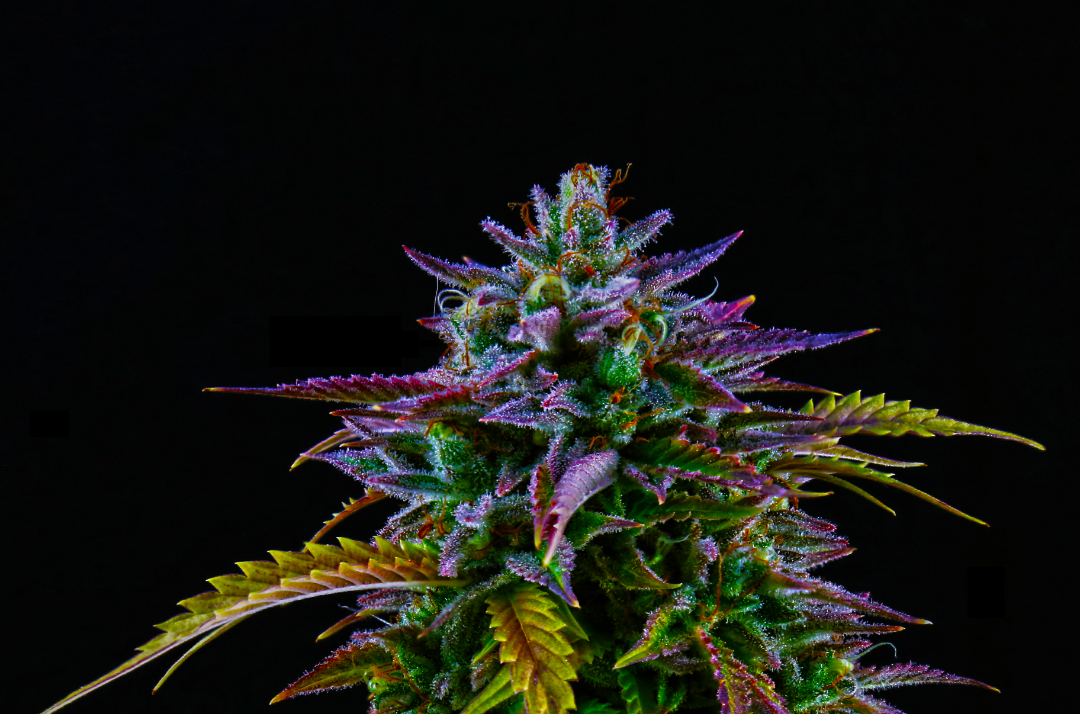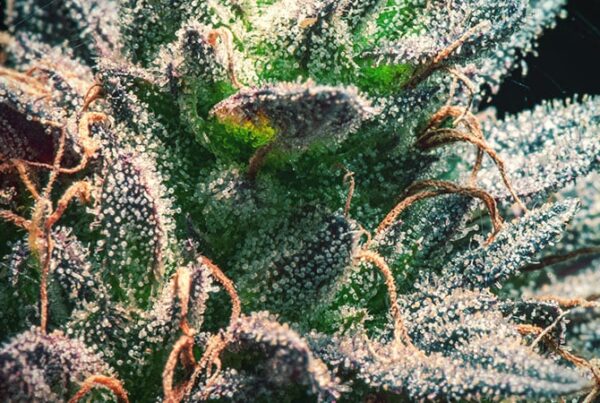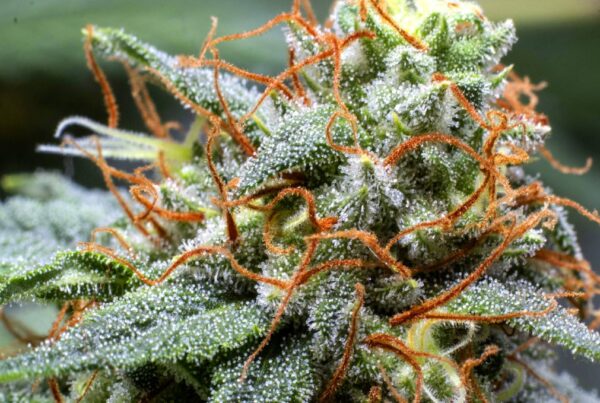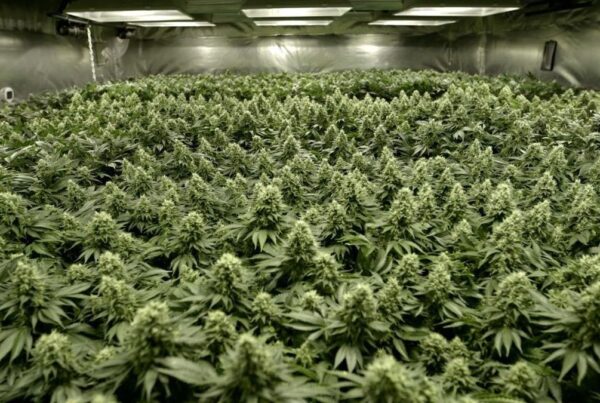If this is your first time growing cannabis, one of the most important things to know is what the cannabis flowering stage is all about. The flowering stage of the cannabis plant involves the plant transitioning from growing only foliage to growing flowers/buds.
During this stage, you’ll see those sticky buds start to form and slowly mature until they’re ready for harvest several weeks later. It’s those handful of weeks of the flowering stage that we’re interested in, so let’s find out what goes on during this time.
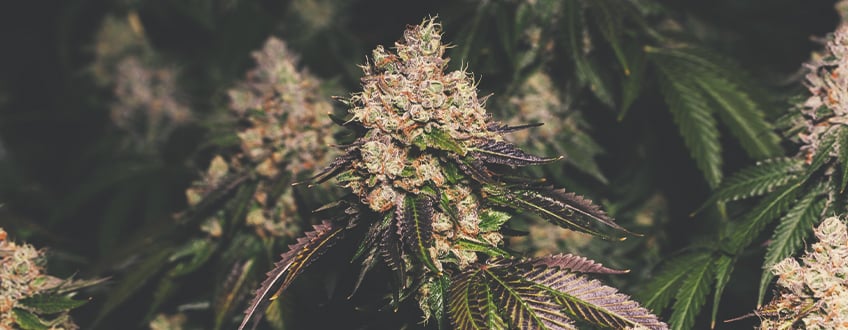
How to Transition to the Flowering Stage
If you are growing photoperiod cannabis plants, it means that they will switch from the vegetative stage to the flowering stage according to the amount of light they get.
This is a natural mechanism that all photoperiod cannabis plants have, to start flowering once the days get shorter and the summer draws to a close, with the aim of reproducing and furthering the lineage.
Autoflowering cannabis plants, on the other hand, will automatically start to flower no matter what light cycle they are on.
For those growing cannabis indoors, this means switching from a 24/0 or 18/6 lighting cycle to a flowering lighting cycle such as 11/11 or 12/12. By reducing the number of hours you give your cannabis plants light, it will cause them to switch to their flowering phase in response to that reduced light.
Week-by-Week Breakdown of the Cannabis Flowering Stage
To give you a good idea of what to look for during the flowering stage, so you know that your plants are on track, we’ll do a week-by-week breakdown of the eight (or more) weeks that the cannabis flowering stage lasts for.

Week 1: The Transition
During week one of flowering, your cannabis plant will start to transition into flower-making mode. This is also known as the pre-flowering stage, and here you’ll see an extreme growth spurt where your plant could grow several inches per day.
You’ll also notice calyxes forming, which look like small teardrops, along with small white hairs known as pistils (if the plant is female) emerging from those same locations.
For the flowering stage, you’ll want to keep the temperature around 78-82°F / 26-28°C during the day, and around 62-70°F / 17-21°C during the night. A general recommendation for beginners is to keep the relative humidity between 50% and 60%. Although, those chasing after VPD may aim for different conditions.
Week 2: Pistil and Bud Growth
During week two, you’ll see those white hairs start to multiply and grow in large numbers from the budding site, and they’ll spread quickly. This is when bud growth starts. If your plant is a male, it will start to grow pollen sacs instead of white hairs.
This is also when you should start providing your cannabis plant with flowering nutrients, which generally means less nitrogen, but more potassium and phosphorus. Make sure to keep an eye out for either nutrient deficiencies or nutrient toxicities as you switch from veg to bloom nutrients.
Week 3: Development of Buds
During the third week, you should notice buds starting to take shape and grow in size, along with a remarkable increase in odor.
As more trichomes are produced, the smell of the cannabis plant will intensify, thanks to the terpenes and other oils in the trichomes.
At this point, you can increase the amount of nutrients being given to the plants, with a good NPK ratio for the mid-flowering stage being 6-10-15.
Week 4: Continued Bud Growth
By the fourth week of the flowering stage, buds should have reached a decent size, they should be smelly, and they should be noticeably sticky to the touch.
Those trichomes are producing more and more resin. At this point, often known as the mid-flowering stage, many growers will aim for a relative humidity between 40% and 60%. The temperature to aim for is the same as previous weeks.

Weeks 5 and 6: The Peak Flowering Period
During weeks five and six of flowering, the buds should grow dramatically in size, become denser, and continue to increase their odor output.
At this point, your cannabis plants will want more calcium, so be sure to supplement it into their diet.
Keep the same temperature and relative humidity as the previous weeks in order to help maximize growth.
Weeks 7, 8, and Beyond
At around the seven week mark, the cannabis buds will start to ripen, which means that they are reaching their maximum potential in terms of cannabinoid and terpene content. You’ll notice those white pistils turn an orange-brown color, and the trichomes should turn milky white (if looked at through a microscope).
Many growers will lower the lights on temperature to around 78°F / 25°C in order to help conserve terpenes. Additionally, some growers will lower the relative humidity in order to help ensure they are in the optimal VPD range.
When most of the trichomes have turned color, it’s time for harvest. Just be sure to not wait too long, or else the buds will be over-ripe, at which point the THC and other beneficial components start to degrade.
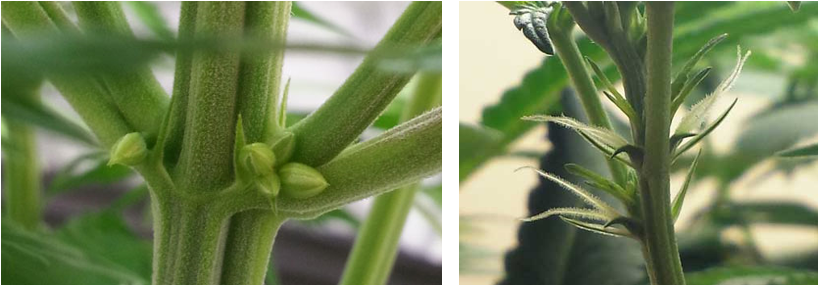
Sexing Cannabis Plants During the Flowering Stage
An essential practice is sexing cannabis plants. If you did not get feminized seeds, there’s about a 50% chance your plants will turn out male.
Male cannabis plants aren’t useful to most growers; They don’t grow buds, but rather pollen sacs. If the pollen sacs burst and pollinate the female plants, the female plant will start to grow seeds within its buds.
Being able to tell males and females apart, and remove the males from the crop as soon as they appear, is therefore essential.
The best way to tell is by looking at the bud sites. Female plants will grow those white hairs known as pistils, whereas males grow small pollen sacs that look like little, round balls. Those pollen sacs usually appear a bit earlier than the pistils on female plants.
The Cannabis Flowering Period: Final Thoughts
The flowering stage is the most exciting stage for most growers. Buds form on female plants while pollen sacs form on male plants. Therefore, keep a close eye on your cannabis plants as they mature, and pay close attention to any signs of male plants, so you can remove them before they ruin the crop.
Make sure to maintain a proper lighting schedule, temperature, relative humidity, and keep an eye out for nutrient deficiencies and toxicities. If you do all of this, you should end up with an excellent, high-quality yield of cannabis flowers.
![]()

